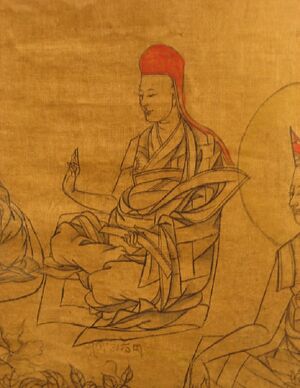Śākya Chokden's Polemical Trilogy on Mahāmudrā, The Wheel of Brahma[edit]
In three short works in the seventeenth volume of his Collected Writings, Śākya Chokden discusses his understanding of Mahāmudrā as presented by Gampopa through the latter's practical instruction of the Single White Remedy (སྨན་དཀར་པོ་གཅིག་ཐུབ་).
In the first book entitled Undermining the Haughtiness of Others by the Wheel of Brahma: A Treatise Clarifying Mahāmudrā (ཕྱག་རྒྱ་ཆེན་པོ་གསལ་བར་བྱེད་པའི་བསྟན་བཅོས་ཚངས་པའི་འཁོར་ལོས་གཞན་བློའི་དྲེགས་པ་ཉམས་བྱེད།), he seeks to explain the luminous nature of the mind, which he says is also popularly given the name Mahāmudrā in Tibet (སེམས་ཀྱི་རང་བཞིན་འོད་གསལ་ལ།། ཕྱག་རྒྱ་ཆེན་པོའི་མཚན་གསོལ་ནས། །གངས་ཅན་ལྗོངས་སུ་ཆེར་གྲགས་པ། །དེ་ཉིད་མདོ་ཙམ་གསལ་བར་བྱ།།). In elucidating the Mahāmudrā advocated by Gampopa, he presents a detailed explanation of it by pointing out that the Mahāmudrā in this context is the luminous nature of the mind which is common to all Mahāyāna traditions and the one which is explicitly taught in the works of Maitreya, particularly in the Ultimate Continuum. This nature is totally obscured or tainted in the ground phase (གཞི་དུས་མ་དག་པ་), partially tainted or obscured at the path phase (ལམ་དུས་ཕྱོགས་གཅིག་དག་པ་), and fully purified at the fruition phase (འབྲས་དུས་ཐམས་ཅད་དག་པ་). He writes that the basic element of buddha-nature is the ground to be purified, the stains to be removed are ninefold (perhaps referring to the nine analogies used to illustrate how buddha-nature is obscured by the afflictive emotions), the antidote which purifies is the discernment of buddha-nature, and the final result is the perfection of purity, self, and bliss. A resemblance of the final result is already perceived on the path of seeing, and such experience of buddha-nature is said to be the seeing of Mahāmudrā.
In brief, he states that Mahāmudrā in this context is not the emptiness of nonimplicative negation as argued in the scholastic writings of Nāgārjuna but what is taught in the writings of Maitreya, or the definitive ultimate reality taught in the third turning after having taught self-emptiness in the middle turning. He then explains how such nature is actualized through meditation by removing the dualistic conceptual thoughts and emotions which are included in the eight types of consciousness that characterize the three realms of the cycle of existence. In the final section, he refutes several misunderstandings and criticisms concerning Mahāmudrā and argues that this Mahāmudrā cannot be realized merely through conceptual reasoning but through the practice of nonmentation, with the help of instructions which point out the nature of the mind and devotion to the guru. Intellectual study and single-pointed concentration are not prerequisites for the experience of Mahāmudrā. He adds that positing the emptiness which is a nonimplicative negation after a reductionist analysis as Mahāmudrā is not in accordance with the Ultimate Continuum or the purport of the hymns by Saraha.
In the second work, A Treatise on the Distinctions of Mahāmudrā (ཕྱག་རྒྱ་ཆེན་པོའི་ཤན་འབྱེད་ཅེས་བྱ་བའི་བསྟན་བཅོས།), Śākya Chokden lists the five types of misinterpretation of the actual point of Mahāmudrā practice:
- 1. The emptiness posited through Mādhyamika reasoning.
2. The union of emptiness and bliss which fills the network of channels after the tantric practice of consecration.
3. Experience of bare consciousness free from all mentation.
4. Nonapprehension of the mind either inside or outside, having color and shape, etc.
5. The ground consciousness which is the cause of all experience.
He states that none of these capture the profound, precise, effective Mahāmudrā technique of Gampopa, which is compared to the Single White Remedy, and explains how they are not the same as Gampopa's Mahāmudrā. For instance, the first position concerns emptiness which is a nonimplicative negation espoused by Mādhyamika thinkers, associated with conceptual thought and established through logical reasoning, whereas Mahāmudrā is primordial wisdom which is discerned by direct experience triggered by devotion, blessings of the guru, and one's karmic merit. The second case is what is taught in the tantras and not the one advocated by Gampopa in the context of the sūtras.
Śākya Chokden distinguishes the above positions and also Chinese Chan practice from Gampopa's Mahāmudrā and goes on to explain their differences and elaborate the practice of Mahāmudrā through the four points of single-pointedness (རྩེ་གཅིག་), nonelaboration (སྤྲོས་བྲལ་), one taste (རོ་གཅིག་), and nonmeditation (སྒོམ་མེད་).
The third book in his trilogy on Mahāmudrā, The Great Ship Unity: A Treatise that Dispels Misinterpretations of the Perspective of Mahāmudrā in Terms of Both the Scriptures and Reasonings (ལུང་རིགས་གཉིས་ཀྱིས་ཕྱག་རྒྱ་ཆེན་པོའི་བཞེད་ཚུལ་ལ་འཁྲུལ་པ་སེལ་བའི་བསྟན་བཅོས་ཟུང་འཇུག་གྲུ་ཆེན།), comprises his responses to a list of questions raised by a certain scholar named Karma Wangchuk Pel with regard to Sakya Paṇḍita's critique of neo-Mahāmudrā and Single White Remedy in his Distinguishing the Three Vows.
He begins with a cogent presentation of Mahāmudrā, covering its sources, the objective Mahāmudrā, the subjective Mahāmudrā, its synonyms, the actual Mahāmudrā experience among sublime beings, the analogous Mahāmudrā understanding among ordinary practitioners, and the Mahāmudrā concept according to the philosophical and tantric schools. Following this, he delves into how some later followers of the Sakya and Kagyu traditions do not fathom the understanding of the their respective teachings. He also points out how the followers of the Kadampa tradition have missed the important original teachings of Atīśa and founding fathers.
In summary, Śākya Chokden underscores the point that there are two ways in which misconceptions are overcome: through an extroverted rational analysis and an introverted yogic contemplation. The Mahāmudrā tradition of Gampopa belongs to the latter category, while the former includes the postulations of self-emptiness and other-emptiness.
Weekly quote[edit]
~

